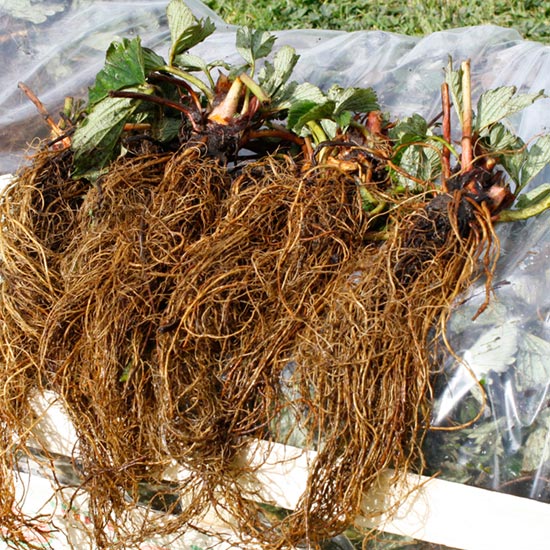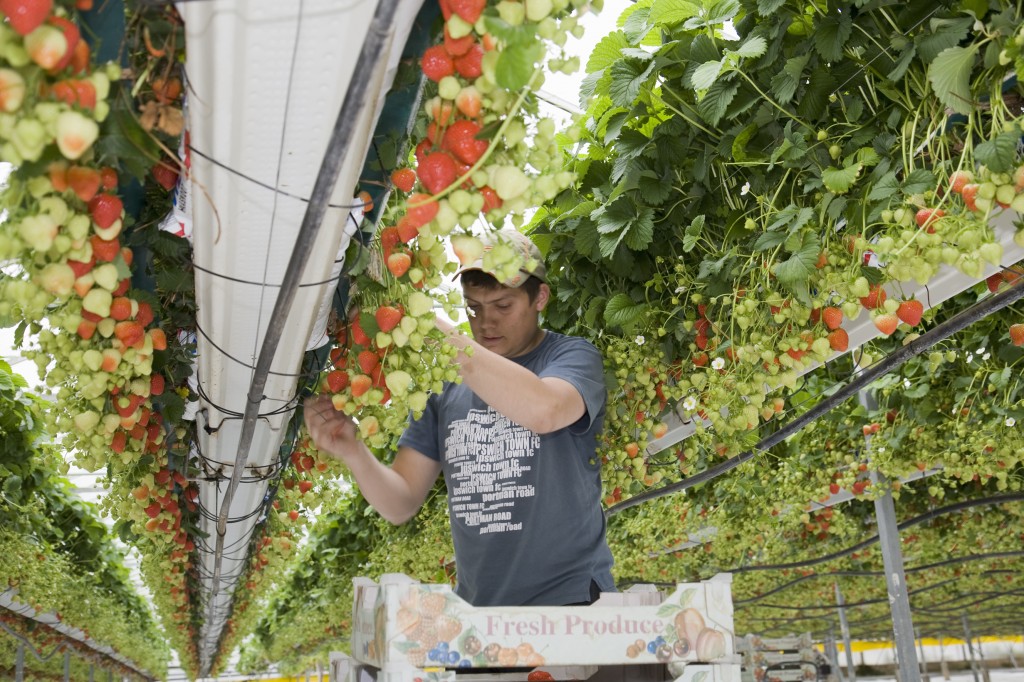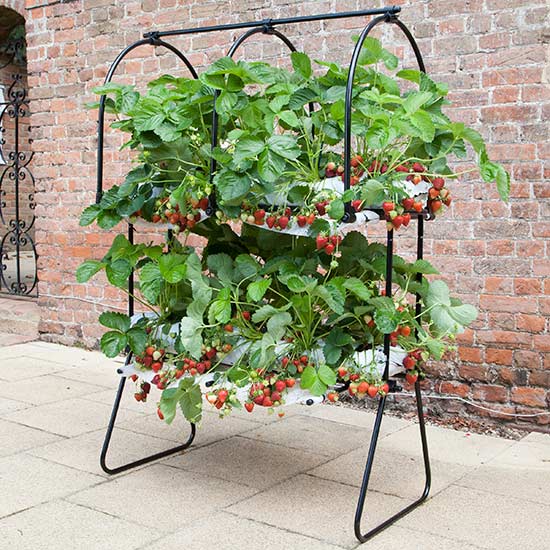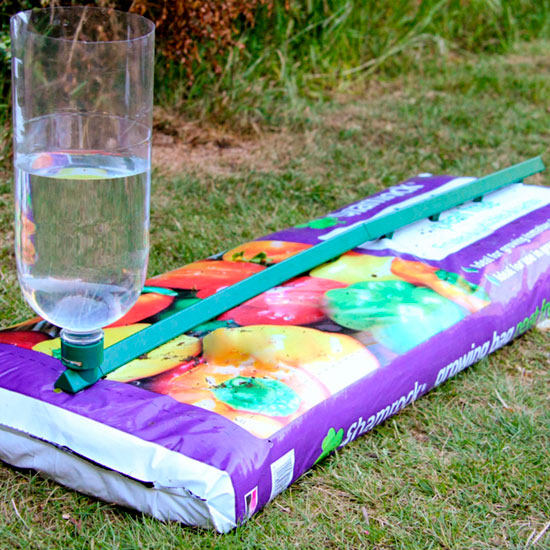The strawberry today is as popular as ever before and whilst they can be easily grown in the ground in the garden or allotment, I suggest that you consider growing them at a raised level in growbags and this will make the whole process of strawberry cultivation much easier. This is known as tabletop growing and is what the commercial growers do now so there is every reason to follow them.
There are huge advantages to growing strawberries in this way – you do not need to worry about soil borne diseases (which can particularly affect strawberries) or pests such as snails and slugs, you can plant more plants for a given area and planting, watering, feeding and picking is so much easier. Additionally for the less able this method of cultivation becomes doesn’t involve backbreaking bending.
Purpose made tabletop frames can be purchased from Pomona Fruits and these will hold two growbags. Alternatively you can make your own table top using old benches, wooden boxes or old crates as long as they are strong enough to hold well watered grow bags which can be very heavy. For this reason I suggest that you do not use garden tables etc. unless they have been reinforced – after all it would be tragic if your whole structure collapsed one day!
You can grow tabletop strawberries out in the open or under some form of protection such as a greenhouse or polytunnel. Obviously if you can grow under some form of protection which will prevent spring evening chills getting to the plants you will be able to achieve earlier cropping.
I recommend that you use good quality growbags from a reputable manufacturer. In this way you will get the largest size with a good quality filling. The cheap growbags you often find at supermarkets etc. for 99p or so are usually smaller than most and the filling is of little substance. The good thing, though, with paying a little extra for a quality growbag is that you will be able to get up to 10 plants per bag which means a lot of strawberries! You will need to provide drainage for the bags just in case overwatering occurs. This is best achieved by small slits at each end of the growbag just below half way and small holes in the bottom of the growbags in any place that they overhang the supports.
The best plants to use are those which have been kept chilled and once planted will give a crop within 60 days. (You will find that flowers start to appear within two to four weeks of planting which I always think is very exciting!). It is best to get stronger growing plants for growbags and SuperCrowns are ideal and will give you the best results. Cultivars available include ‘Elegance’, ‘Fenella’ and ‘Sonata’. If you have space for two growbags you could grow two different cultivars and with careful selection of varieties you can extend your cropping season.

You can maximise the yield of the 60 day crop by planting SuperCrowns. These are coldstored runners that have a crown size of 15mm or more in diameter.
Always buy from a reputable source like Pomona Fruits where certified disease free plants are sold as this is the only way to guarantee that you get good plants which will provide you with a good crop for a couple of years or so. I can assure you that any extra cost involved in buying this way will be well worth it. Please do not be tempted to buy your plants from general stores, car boot sales etc. or take a few from friends and neighbours. It is highly likely that these will be runners which have been taken from plants that are already are succumbing to disease. You have been warned!
Maintenance wise strawberries are quite easy to look after. The most important thing to do with table top strawberries is to ensure that they are watered and fed properly. Initially the plants will require very little water. They should be planted in to damp compost and the compost should be kept moist at all times. Once the plants start flowering you will need to increase the frequency of watering and may well need to water once or twice daily in sunny, warm weather. It is equally important to apply a liquid feed that is high in potash at regular intervals once the plants have flowered. A good tomato fertiliser should do the job well and should be applied at the same time as watering. As it isn’t always possible to gauge whether growbags are wetted all the way through I thoroughly recommend effective proprietary watering and irrigation aids. Growtubes or Speed Feed Growbag Irrigators are very suitable aids for this purpose – they are cheap to buy and are very effective.
To ensure that your strawberry plants grow well and remain strong remove any runners that are produced and remove any leaves that have turned brown. If growing outside and frosty conditions are forecast cover the plants with fleece, old net curtains etc and this should prevent the flowers from becoming frosted.
From June onwards your plants will produce runners and you should always remove them as they can seriously weaken the plants.
Pick the strawberries as often as they are ripe and do not let overripe berries remain on the plants as this encourages the growth of mildews and moulds.
As soon as the strawberry plants have fruited you should cut off all leaves as close as you can to the crown without damaging it and this will enable the plants to build up for the following year’s crop. The leaves should again be cut off in February and the new leaves will help the plants produce the next crop.
Strawberry plants will not last much longer than three years before they deteriorate and at the end of this period you should replace them with fresh stock in new growbags. If you add up the costs of plants and growbags for the three year period you will realise just what value you have achieved from them!
Gerry Edwards
14th May 2013
Gerry is an experienced amateur fruit grower who is Chairman of the RHS Fruit Group, a member of the Royal Horticultural Society’s Fruit, Vegetable and Herb Committee and also their Fruit Trials Panel. Gerry judges fruit nationally for the Royal Horticultural Society and is also a qualified National Vegetable Society judge.




I was very impressed with this information, it has inspired me to try my hand at growing strawberries. Thank you.